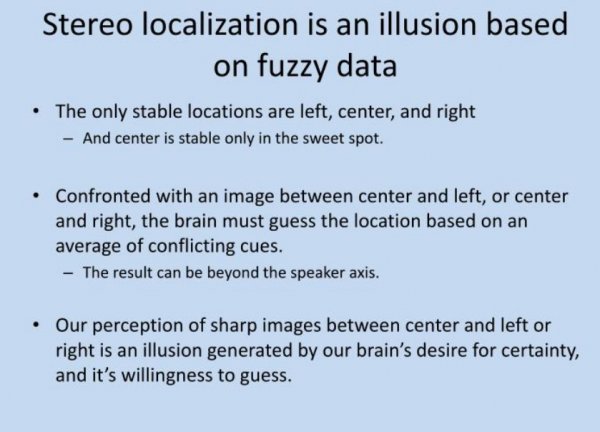I am fascinated by the comments that focus on reproduction and our stereos. The point I'm trying to make is that when I listen to someone speak in a room, people around a dinner table, or when I listen to an instrument or group of instruments, either up close or further back, I never hear a precise outlined image of the musician, instrument, singer, or what have you. Are people arguing that real sound is precise like that, with clearly heard dimensions and shapes, even if heard from really up close?
I think sound can be super clean and clear, but images are not in focus like a photograph. They are a bit fuzzy. Edges are blurred, sometimes more, sometimes less. And depending on the space, the recording, or how it is captured, it varies. There is no absolute, and instruments sound different depending on where they are heard. Often, the whole instrument is vibrating and creating energy in the form of sound. Is this precise and can we easily determine the size and shape with our eyes closed? Not in my experience. We can usually localize the source of the sound quite well, and I don't want to lose the ability to do that from my system. I also want to hear differences between recordings, but I no longer want to "see" precise and outlined images from my audio system.
One of my visitors when asked where the cello was while we listened to a string trio pointed right between the speakers and said "there". He pointed his finger to a location. The other listener heard the cello as a diffuse blob enlarged to fill the space between my two speakers. I heard the cello as being centered about ten feet in front of us and between the viola and violin. It was not huge, and it was not precisely outlined, but the sound was big. What accounts for this difference in perception? This is where subjective listening comes in and different priorities. I think we all hear differently, and we have different ways of describing what we hear. We also prefer different sounds.
I just don't hear a cello as a three foot box of wood fifteen inches above the floor when I hear it played right in front of me. I see it, but it sounds bigger and less specific in shape and size. And because I don't hear it as I see it when listening to it live, under any circumstances, I don't want to hear it precisely outlined from my audio system. My system used to sound more like that, and other systems I know have an even more precise and focused sense of images. I think people like that, which is fine, but, in my experience, that is not how I hear it. That is why I am moving away from it in my listening room.
There have also been some comments that by making the sound more diffuse or less focused, it will all sound the same. This is also not my goal or the effect I hear. In fact, these changes have brought out more differences between recordings, not fewer. I wrote some comments after hearing Al's system a few weeks ago. His system sounded more "alive" to me than it had ever before. It breathes more now. I hear that same thing in my system now. There is more "life" to the sound. There is more air, more atmosphere. This too is what I hear with live music. It breathes, it is full of energy, and it is alive.








